Wildfire CO2 Emissions in the Conterminous United States from 2015 to 2018 as Estimated by the WRF-Chem Assimilation System from OCO-2 XCO2 Retrievals
Abstract
1. Introduction
2. Materials and Methods
2.1. A Regional CO2 Transport Model
2.2. CO2 Concentration Assimilation System
2.3. Wildfire Emissions Estimate Model
2.4. Wildfire Emissions of CT2019B
2.5. Experiment Design
2.6. Wildfire Emissions Estimate Method
2.7. Evaluation Data
2.8. Evaluation Metrics
3. Results and Discussion
3.1. Experiments Results
3.2. Wildfire CO2 Emissions Experiments Results
3.3. Effect of OCO-2 Retrievals
4. Conclusions
Author Contributions
Funding
Institutional Review Board Statement
Informed Consent Statement
Data Availability Statement
Acknowledgments
Conflicts of Interest
Appendix A
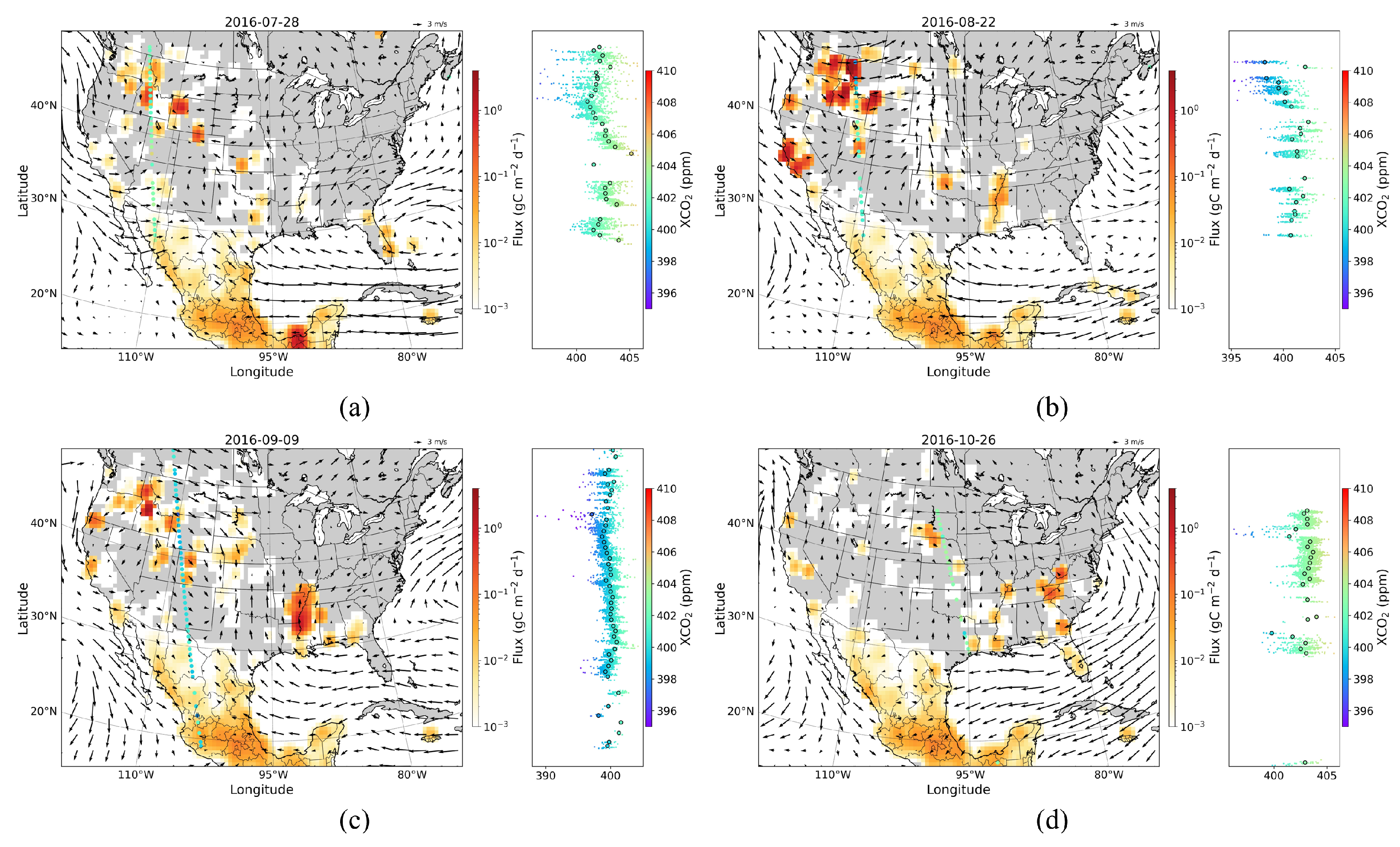

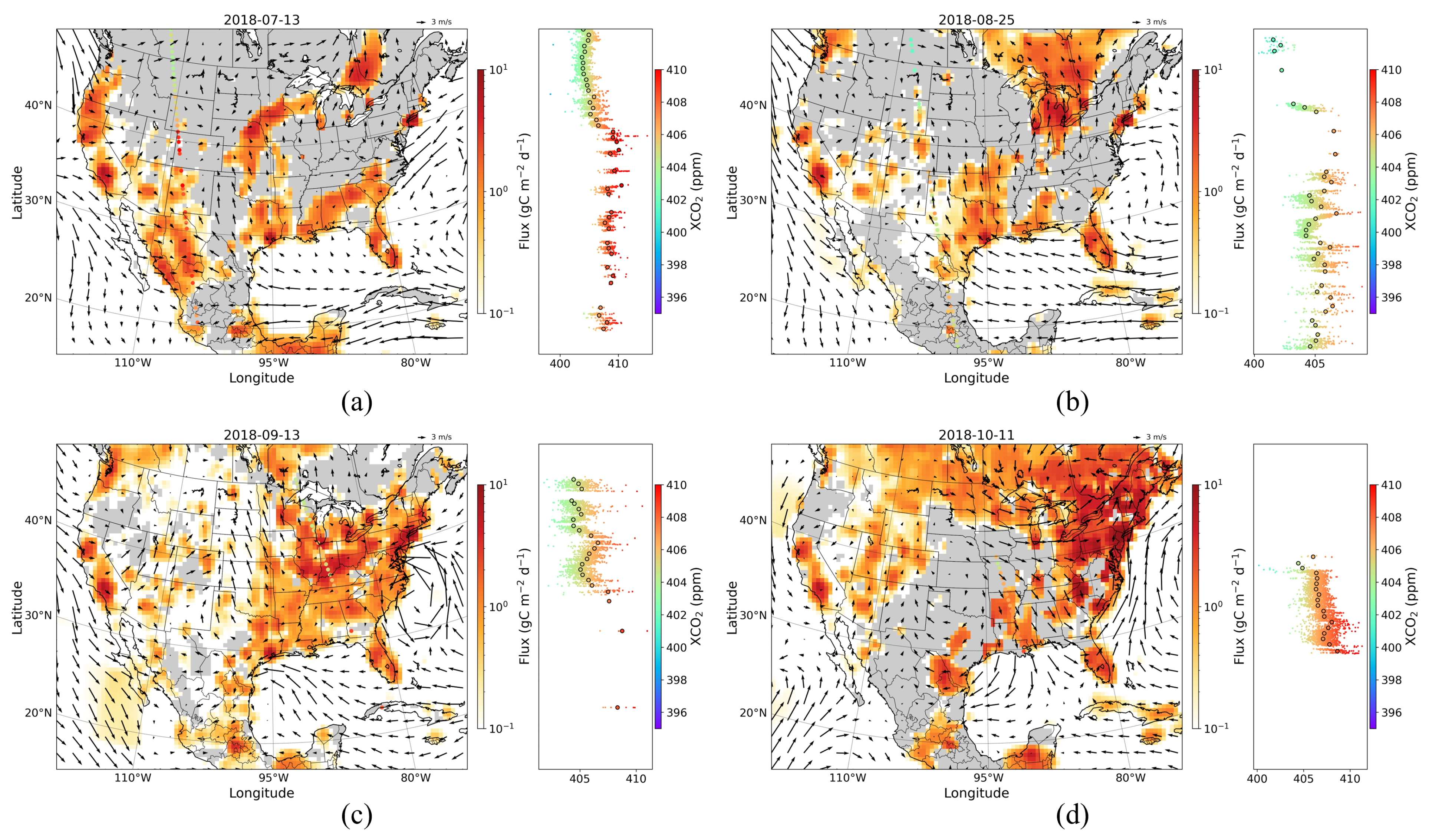
References
- Andreae, M.O.; Merlet, P. Emission of trace gases and aerosols from biomass burning. Glob. Biogeochem. 2001, 15, 955–966. [Google Scholar] [CrossRef]
- Change, I.C. Contribution of working groups I, II and III to the fourth assessment report of the intergovernmental panel on climate change. Synth. Rep. 2007. [Google Scholar]
- Langmann, B.; Duncan, B.; Textor, C.; Trentmann, J.; van der Werf, G.R. Vegetation fire emissions and their impact on air pollution and climate. Atmos. Environ. 2009, 43, 107–116. [Google Scholar] [CrossRef]
- Jaffe, D.A.; Wigder, N.L. Ozone production from wildfires: A critical review. Atmos. Environ. 2012, 51, 1–10. [Google Scholar] [CrossRef]
- Bond, T.C.; Doherty, S.J.; Fahey, D.W.; Forster, P.M.; Berntsen, T.; DeAngelo, B.J.; Flanner, M.G.; Ghan, S.; Kärcher, B.; Koch, D.; et al. Bounding the role of black carbon in the climate system: A scientific assessment. J. Geophys. Res. Atmos. 2013, 118, 5380–5552. [Google Scholar] [CrossRef]
- Lorenz, K.; Lal, R. Introduction. In Carbon Sequestration in Forest Ecosystems; Springer: Dordrecht, The Netherlands, 2010; pp. 1–21. [Google Scholar]
- Mead, M.I.; Castruccio, S.; Latif, M.T.; Nadzir, M.S.M.; Dominick, D.; Thota, A.; Crippa, P. Impact of the 2015 wildfires on Malaysian air quality and exposure: A comparative study of observed and modeled data. Environ. Res. Lett. 2018, 13, 044023. [Google Scholar] [CrossRef]
- Burke, M.; Driscoll, A.; Heft-Neal, S.; Xue, J.; Burney, J.; Wara, M. The changing risk and burden of wildfire in the United States. Proc. Natl. Acad. Sci. USA 2021, 118, e2011048118. [Google Scholar] [CrossRef]
- Li, A.X.; Wang, Y.; Yung, Y.L. Inducing Factors and Impacts of the October 2017 California Wildfires. Earth Space Sci. 2019, 6, 1480–1488. [Google Scholar] [CrossRef]
- Rooney, B.; Wang, Y.; Jiang, J.H.; Zhao, B.; Zeng, Z.C.; Seinfeld, J.H. Air quality impact of the Northern California Camp Fire of November 2018. Atmos. Chem. Phys. 2020, 20, 14597–14616. [Google Scholar] [CrossRef]
- Wang, D.; Guan, D.; Zhu, S.; Kinnon, M.M.; Geng, G.; Zhang, Q.; Zheng, H.; Lei, T.; Shao, S.; Gong, P.; et al. Economic footprint of California wildfires in 2018. Nat. Sustain. 2021, 4, 252–260. [Google Scholar] [CrossRef]
- Zheng, B.; Ciais, P.; Chevallier, F.; Yang, H.; Canadell, J.G.; Chen, Y.; van der Velde, I.R.; Aben, I.; Chuvieco, E.; Davis, S.J.; et al. Record-high CO2 emissions from boreal fires in 2021. Science 2023, 379, 912–917. [Google Scholar] [CrossRef]
- Bond-Lamberty, B.; Peckham, S.D.; Ahl, D.E.; Gower, S.T. Fire as the dominant driver of central Canadian boreal forest carbon balance. Nature 2007, 450, 89–92. [Google Scholar] [CrossRef] [PubMed]
- Rosa, I.M.D.; Pereira, J.M.C.; Tarantola, S. Atmospheric emissions from vegetation fires in Portugal (1990–2008): Estimates, uncertainty analysis, and sensitivity analysis. Atmos. Chem. Phys. 2011, 11, 2625–2640. [Google Scholar] [CrossRef]
- Miranda, A.; Coutinho, M.; Borrego, C. Forest fire emissions in Portugal: A contribution to global warming? Environ. Pollut. 1994, 83, 121–123. [Google Scholar] [CrossRef]
- Shi, Y.; Yamaguchi, Y. A high-resolution and multi-year emissions inventory for biomass burning in Southeast Asia during 2001–2010. Atmos. Environ. 2014, 98, 8–16. [Google Scholar] [CrossRef]
- Ross, A.N.; Wooster, M.J.; Boesch, H.; Parker, R. First satellite measurements of carbon dioxide and methane emission ratios in wildfire plumes. Geophys. Res. Lett. 2013, 40, 4098–4102. [Google Scholar] [CrossRef]
- Ban, Y.; Zhang, P.; Nascetti, A.; Bevington, A.R.; Wulder, M.A. Near Real-Time Wildfire Progression Monitoring with Sentinel-1 SAR Time Series and Deep Learning. Sci. Rep. 2020, 10, 1322. [Google Scholar] [CrossRef] [PubMed]
- Liu, X.; He, B.; Quan, X.; Yebra, M.; Qiu, S.; Yin, C.; Liao, Z.; Zhang, H. Near Real-Time Extracting Wildfire Spread Rate from Himawari-8 Satellite Data. Remote Sens. 2018, 10, 1654. [Google Scholar] [CrossRef]
- Van Der Werf, G.R.; Randerson, J.T.; Giglio, L.; Van Leeuwen, T.T.; Chen, Y.; Rogers, B.M.; Mu, M.; Van Marle, M.J.E.; Morton, D.C.; Collatz, G.J.; et al. Global fire emissions estimates during 1997–2016. Earth Syst. Sci. Data 2017, 9, 697–720. [Google Scholar] [CrossRef]
- Van der Werf, G.R.; Randerson, J.T.; Giglio, L.; Collatz, G.J.; Mu, M.; Kasibhatla, P.S.; Morton, D.C.; DeFries, R.S.; Jin, Y.; Van Leeuwen, T.T. Global fire emissions and the contribution of deforestation, savanna, forest, agricultural, and peat fires (1997–2009). Atmos. Chem. Phys. 2010, 10, 11707–11735. [Google Scholar] [CrossRef]
- Wiedinmyer, C.; Akagi, S.K.; Yokelson, R.J.; Emmons, L.K.; Al-Saadi, J.A.; Orlando, J.J.; Soja, A.J. The Fire INventory from NCAR (FINN): A high resolution global model to estimate the emissions from open burning. Geosci. Model Dev. Discuss. 2011, 4, 625–641. [Google Scholar] [CrossRef]
- Kaiser, J.W.; Heil, A.; Andreae, M.O.; Benedetti, A.; Chubarova, N.; Jones, L.; Morcrette, J.J.; Razinger, M.; Schultz, M.G.; Suttie, M.; et al. Biomass burning emissions estimated with a global fire assimilation system based on observed fire radiative power. Biogeosciences 2012, 9, 527–554. [Google Scholar] [CrossRef]
- Konovalov, I.B.; Berezin, E.V.; Ciais, P.; Broquet, G.; Beekmann, M.; Hadji-Lazaro, J.; Clerbaux, C.; Andreae, M.O.; Kaiser, J.W.; Schulze, E.D. Constraining CO2 emissions from open biomass burning by satellite observations of co-emitted species: A method and its application to wildfires in Siberia. Atmos. Chem. Phys. 2014, 14, 10383–10410. [Google Scholar] [CrossRef]
- Heymann, J.; Reuter, M.; Buchwitz, M.; Schneising, O.; Bovensmann, H.; Burrows, J.P.; Massart, S.; Kaiser, J.W.; Crisp, D. CO2 emission of Indonesian fires in 2015 estimated from satellite-derived atmospheric CO2 concentrations. Geophys. Res. Lett. 2017, 44, 1537–1544. [Google Scholar] [CrossRef]
- Guo, M.; Li, J.; Xu, J.; Wang, X.; He, H.; Wu, L. CO2 emissions from the 2010 Russian wildfires using GOSAT data. Environ. Pollut. 2017, 226, 60–68. [Google Scholar] [CrossRef] [PubMed]
- Guo, M.; Li, J.; Wen, L.; Huang, S. Estimation of CO2 Emissions from Wildfires Using OCO-2 Data. Atmosphere 2019, 10, 581. [Google Scholar] [CrossRef]
- Wang, J.; Liu, Z.; Zeng, N.; Jiang, F.; Wang, H.; Ju, W. Spaceborne detection of XCO2 enhancement induced by Australian mega-bushfires. Environ. Res. Lett. 2020, 15, 124069. [Google Scholar] [CrossRef]
- Zhang, Q.; Li, M.; Wei, C.; Mizzi, A.P.; Huang, Y.; Gu, Q. Assimilation of OCO-2 retrievals with WRF-Chem/DART: A case study for the Midwestern United States. Atmos. Environ. 2021, 246, 118106. [Google Scholar] [CrossRef]
- Anderson, J.; Hoar, T.; Raeder, K.; Liu, H.; Collins, N.; Torn, R.; Avellano, A. The Data Assimilation Research Testbed: A Community Facility. Bull. Am. Meteorol. Soc. 2009, 90, 1283–1296. [Google Scholar] [CrossRef]
- Hong, S.Y.; Dudhia, J.; Chen, S.H. A Revised Approach to Ice Microphysical Processes for the Bulk Parameterization of Clouds and Precipitation. Mon. Weather. Rev. 2004, 132, 103–120. [Google Scholar] [CrossRef]
- Kain, J.S. The Kain–Fritsch Convective Parameterization: An Update. J. Appl. Meteorol. 2004, 43, 170–181. [Google Scholar] [CrossRef]
- Mlawer, E.J.; Taubman, S.J.; Brown, P.D.; Iacono, M.J.; Clough, S.A. Radiative transfer for inhomogeneous atmospheres: RRTM, a validated correlated-k model for the longwave. J. Geophys. Res. Atmos. 1997, 102, 16663–16682. [Google Scholar] [CrossRef]
- Dudhia, J. Numerical Study of Convection Observed during the Winter Monsoon Experiment Using a Mesoscale Two-Dimensional Model. J. Atmos. Sci. 1989, 46, 3077–3107. [Google Scholar] [CrossRef]
- Gerrity, J.P.; Black, T.L.; Treadon, R.E. The Numerical Solution of the Mellor-Yamada Level 2.5 Turbulent Kinetic Energy Equation in the Eta Model. Mon. Weather. Rev. 1994, 122, 1640–1646. [Google Scholar] [CrossRef]
- Nakanishi, M.; Niino, H. Development of an Improved Turbulence Closure Model for the Atmospheric Boundary Layer. J. Meteorol. Soc. Jpn. Ser. II 2009, 87, 895–912. [Google Scholar] [CrossRef]
- Crowell, S.; Baker, D.; Schuh, A.; Basu, S.; Jacobson, A.R.; Chevallier, F.; Liu, J.; Deng, F.; Feng, L.; McKain, K.; et al. The 2015–2016 carbon cycle as seen from OCO-2 and the global in situ network. Atmos. Chem. Phys. 2019, 19, 9797–9831. [Google Scholar] [CrossRef]
- Anderson, J.L. A Local Least Squares Framework for Ensemble Filtering. Mon. Weather. Rev. 2003, 131, 634–642. [Google Scholar] [CrossRef]
- Mizzi, A.P.; Arellano, A.F., Jr.; Edwards, D.P.; Anderson, J.L.; Pfister, G.G. Assimilating compact phase space retrievals of atmospheric composition with WRF-Chem/DART: A regional chemical transport/ensemble Kalman filter data assimilation system. Geosci. Model Dev. 2016, 9, 965–978. [Google Scholar] [CrossRef]
- Anderson, J.L. Localization and Sampling Error Correction in Ensemble Kalman Filter Data Assimilation. Mon. Weather. Rev. 2012, 140, 2359–2371. [Google Scholar] [CrossRef]
- Hakkarainen, J.; Ialongo, I.; Tamminen, J. Direct space-based observations of anthropogenic CO2 emission areas from OCO-2. Geophys. Res. Lett. 2016, 43, 11400–11406. [Google Scholar] [CrossRef]
- Hakkarainen, J.; Ialongo, I.; Maksyutov, S.; Crisp, D. Analysis of Four Years of Global XCO2 Anomalies as Seen by Orbiting Carbon Observatory-2. Remote Sens. 2019, 11, 850. [Google Scholar] [CrossRef]
- Anderson, J.L. An Ensemble Adjustment Kalman Filter for Data Assimilation. Mon. Weather. Rev. 2001, 129, 2884–2903. [Google Scholar] [CrossRef]
- Gaspari, G.; Cohn, S.E. Construction of correlation functions in two and three dimensions. Q. J. R. Meteorol. Soc. 1999, 125, 723–757. [Google Scholar] [CrossRef]
- Kang, J.S.; Kalnay, E.; Miyoshi, T.; Liu, J.; Fung, I. Estimation of surface carbon fluxes with an advanced data assimilation methodology. J. Geophys. Res. Atmos. 2012, 117. [Google Scholar] [CrossRef]
- CAMS Global Biomass Burning Emissions Based on Fire Radiative Power (GFAS): Data Documentation. Available online: https://confluence.ecmwf.int/display/CKB/CAMS+global+biomass+burning+emissions+based+on+fire+radiative+power+%28GFAS%29%3A+data+documentation (accessed on 15 November 2023).
- Marlier, M.E.; Voulgarakis, A.; Shindell, D.T.; Faluvegi, G.; Henry, C.L.; Randerson, J.T. The role of temporal evolution in modeling atmospheric emissions from tropical fires. Atmos. Environ. 2014, 89, 158–168. [Google Scholar] [CrossRef]
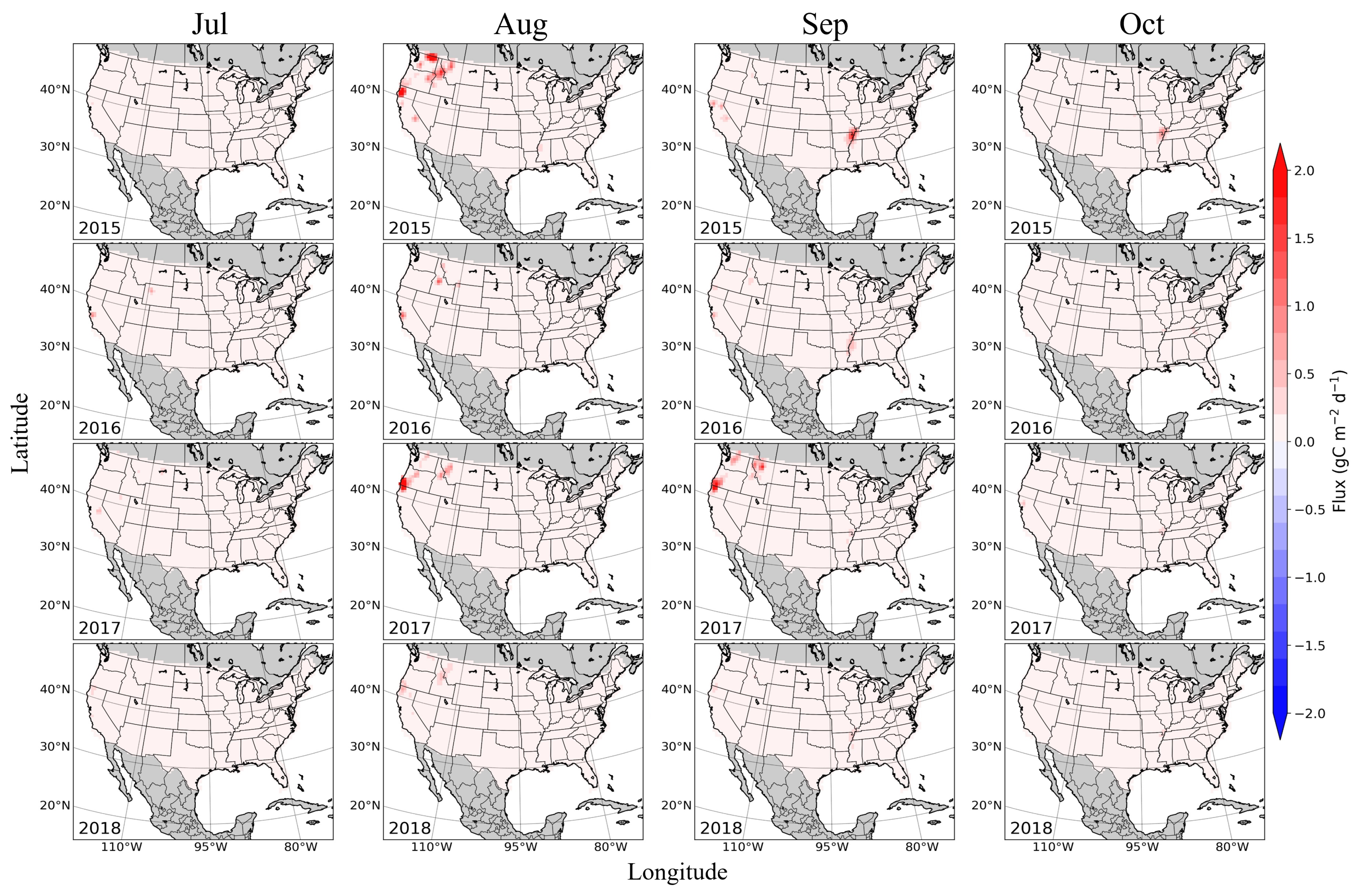
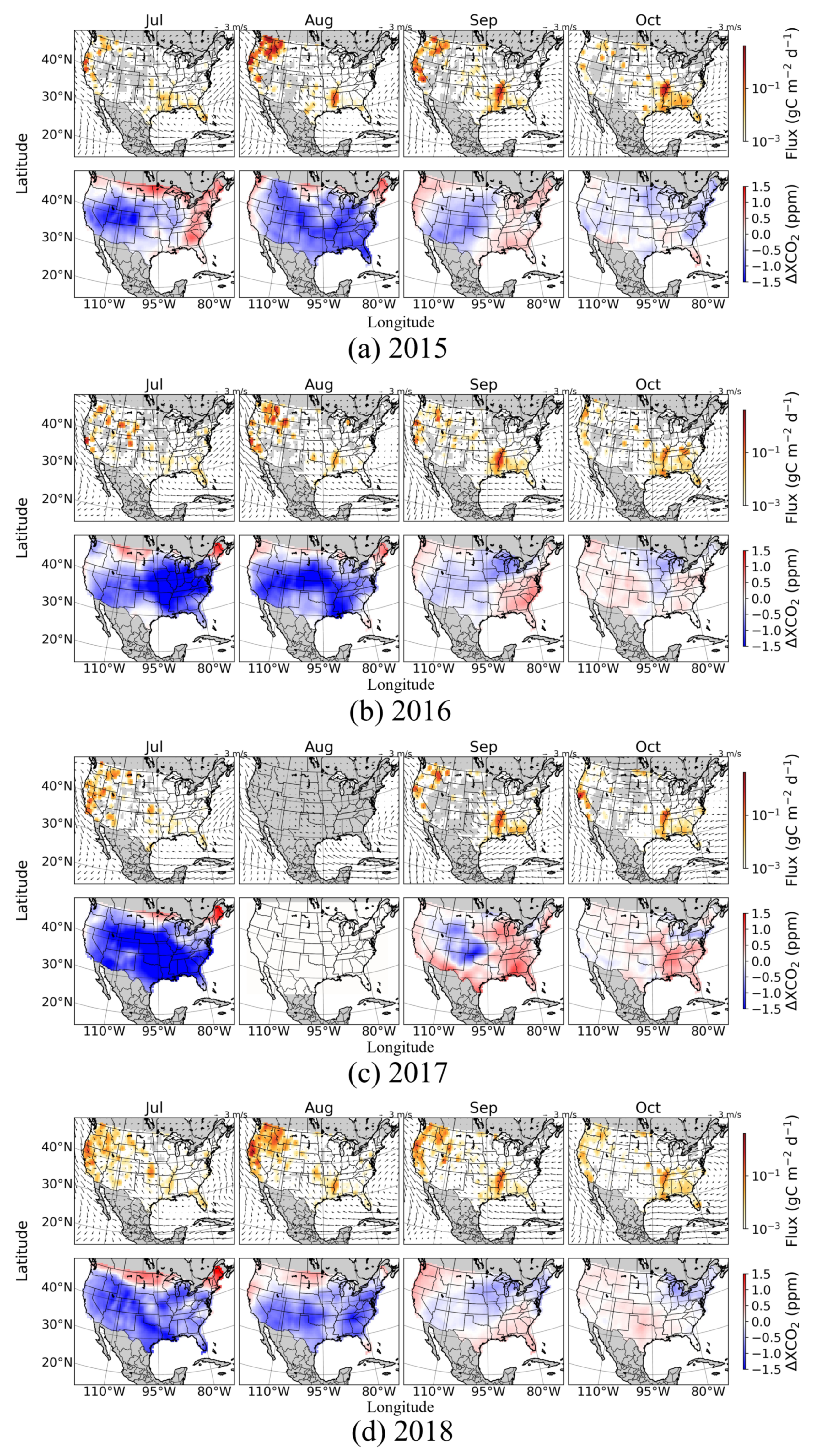
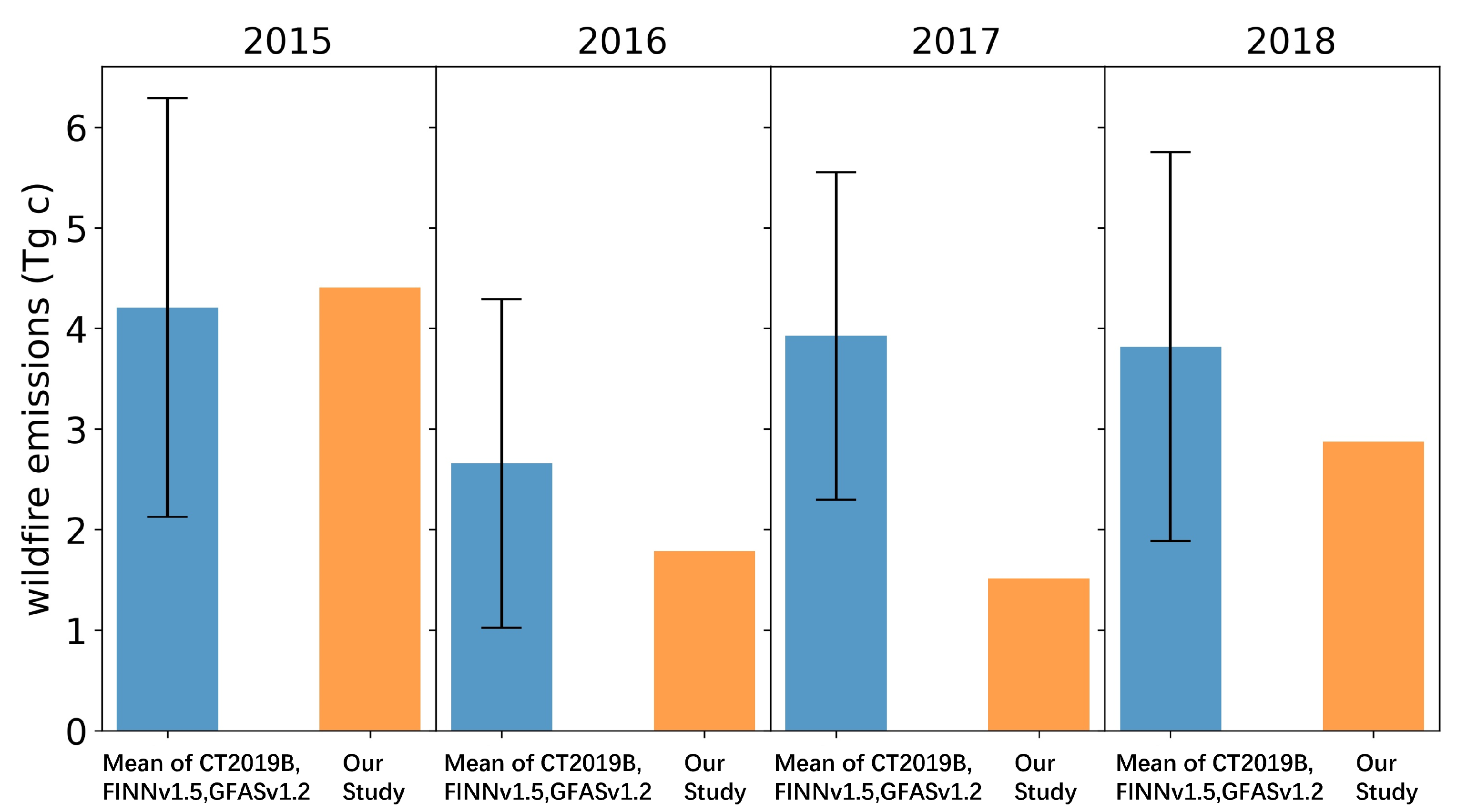

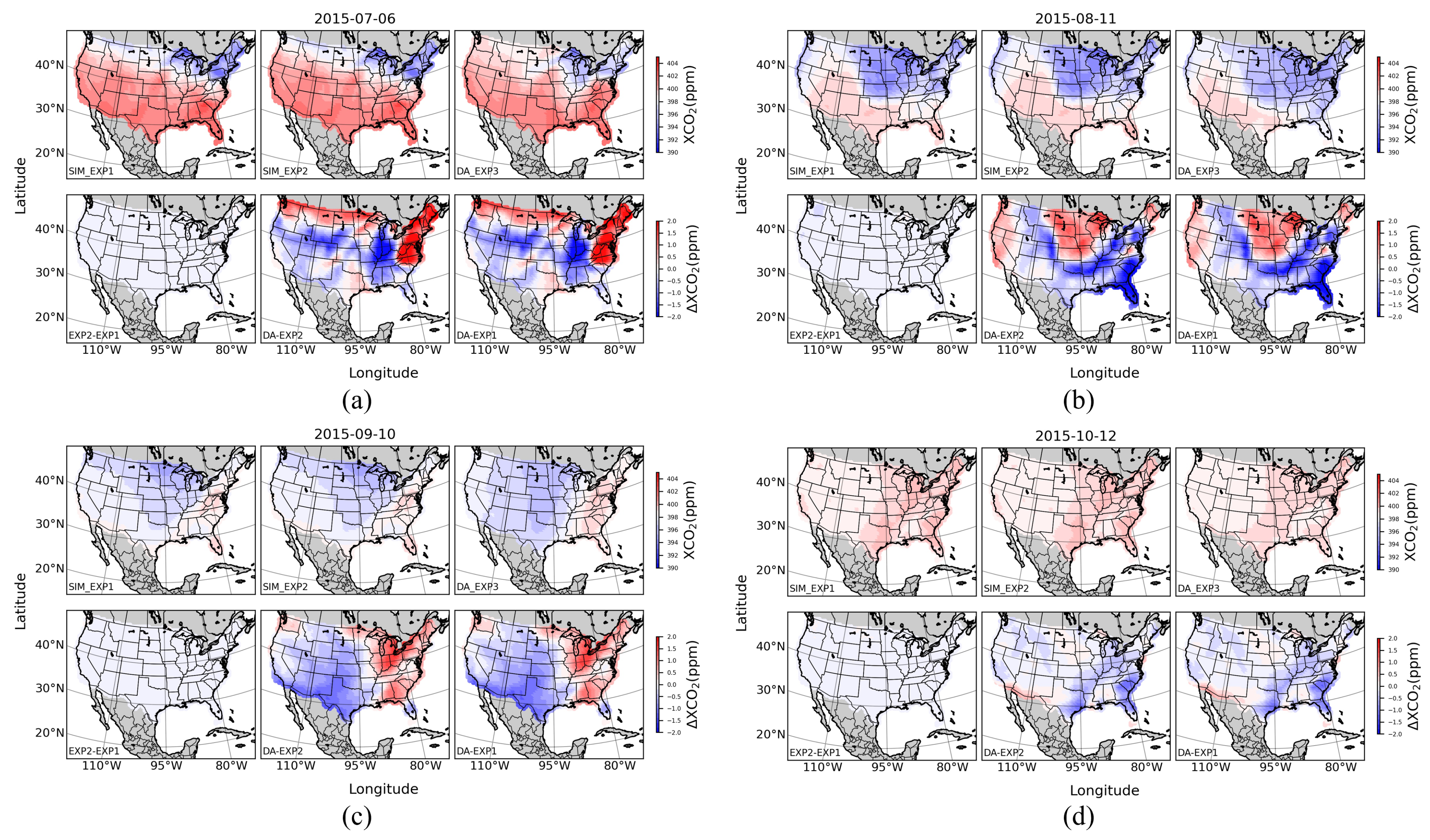
| Options | Configurations |
|---|---|
| WRF_Core | ARW |
| Domain center | N– W |
| Grid resolution | 50 km |
| nx,ny,nz | 103,82,45 |
| Interval seconds | 21,600 s/6 h |
| Time steps | 240 s |
| Start date | 2015~01-07-2018 00:00:00 |
| End date | 2015~01-11-2018 00:00:00 |
| Microphysics process | WSM 5-class simple ice scheme [31] |
| Cumulus parameterization | Kain-Fritsch scheme [32] |
| Longwave atmospheric radiation | RRTM scheme [33] |
| Shortwave atmospheric radiation | Dudhia scheme [34] |
| Planetary boundary layer scheme | MYNN 2.5 level TKE [35] |
| Surface layer scheme | MYNN [36] |
| Land surface scheme | Unified Noah Land surface model |
| Chemistry option | chem_opt = 16 (CO2 only) |
| Experiment Name | Initial and Boundary | Prior Flux | Assimilate or Not | Experiment Time |
|---|---|---|---|---|
| SIM_EXP1 | CT2019B CO2 total mole fractions products | CT2019B optimized fluxes with fire emissions | NO | July to October of 2015∼2018 |
| SIM_EXP2 | CT2019B CO2 total mole fractions products | CT2019B optimized fluxes without fire emissions | NO | July to October of 2015∼2018 |
| DA_EXP3 | CT2019B CO2 total mole fractions products | CT2019B optimized fluxes without fire emissions | YES | July to October of 2015∼2018 |
| Year | July | August | September | October |
|---|---|---|---|---|
| 2015 | 9 | 8 | 8 | 6 |
| 2016 | 6 | 7 | 10 | 10 |
| 2017 | 12 | 0 | 3 | 6 |
| 2018 | 10 | 14 | 18 | 18 |
| Year | Month | SIM_EXP1 (ppm) | SIM_EXP2 (ppm) | DA_EXP3 (ppm) | CT2019B (ppm) |
|---|---|---|---|---|---|
| 2015 | July | 398.60 | 398.58 | 398.22 | 398.29 |
| August | 397.13 | 397.09 | 396.59 | 396.65 | |
| September | 397.67 | 397.65 | 397.61 | 397.36 | |
| October | 399.19 | 399.18 | 398.98 | 398.81 | |
| 2016 | July | 402.06 | 402.06 | 401.41 | 401.86 |
| August | 401.13 | 401.12 | 400.49 | 400.51 | |
| September | 401.22 | 401.21 | 401.12 | 400.77 | |
| October | 402.45 | 402.45 | 402.46 | 402.07 | |
| 2017 | July | 404.77 | 404.76 | 403.69 | 404.21 |
| August | 402.49 | 402.47 | 401.52 | 402.05 | |
| September | 402.97 | 402.95 | 403.01 | 402.45 | |
| October | 404.43 | 404.43 | 404.41 | 404.01 | |
| 2018 | July | 405.83 | 405.82 | 405.39 | 405.61 |
| August | 405.12 | 405.07 | 404.67 | 404.80 | |
| September | 405.68 | 405.66 | 405.56 | 405.21 | |
| October | 406.74 | 406.73 | 406.75 | 406.28 |
| Year | Wildfire Emissions(Tg C) | July | August | September | October | Mean |
|---|---|---|---|---|---|---|
| 2015 | CT2019B | 0.537 | 8.614 | 3.356 | 1.450 | 3.489 |
| FINNv1.5 | 1.840 | 7.238 | 1.872 | 2.246 | 3.299 | |
| GFASv1.2 | 1.154 | 18.391 | 1.319 | 2.481 | 5.836 | |
| Mean of CT2019B, FINNv1.5,GFASv1.2 | 1.177 ± 0.652 | 11.414 ± 6.081 | 2.182 ± 1.053 | 2.059 ± 0.541 | 4.208 ± 2.082 | |
| Our study | 3.568 | 8.251 | 1.552 | 4.263 | 4.408 | |
| 2016 | CT2019B | 0.875 | 1.729 | 1.765 | 0.954 | 1.331 |
| FINNv1.5 | 1.827 | 2.506 | 2.725 | 3.475 | 2.633 | |
| GFASv1.2 | 4.341 | 6.714 | 3.269 | 1.693 | 4.004 | |
| Mean of CT2019B, FINNv1.5,GFASv1.2 | 2.348 ± 1.791 | 3.650 ± 2.682 | 2.586 ± 0.761 | 2.041 ± 1.296 | 2.656 ± 1.633 | |
| Our study | 0.511 | 0.791 | 3.999 | 1.834 | 1.784 | |
| 2017 | CT2019B | 1.202 | 4.204 | 4.622 | 1.210 | 2.810 |
| FINNv1.5 | 1.553 | 4.664 | 6.629 | 3.949 | 4.199 | |
| GFASv1.2 | 6.803 | 3.317 | 6.982 | 1.966 | 4.767 | |
| Mean of CT2019B, FINNv1.5,GFASv1.2 | 3.186 ± 3.137 | 4.062 ± 0.685 | 6.078 ± 1.273 | 2.375 ± 1.415 | 3.925 ± 1.627 | |
| Our study | 1.758 | NA | 0.733 | 2.052 | 1.514 | |
| 2018 | CT2019B | 1.556 | 3.568 | 1.620 | 0.733 | 1.869 |
| FINNv1.5 | 3.905 | 7.771 | 2.918 | 3.168 | 4.441 | |
| GFASv1.2 | 6.071 | 8.340 | 4.803 | 1.354 | 5.142 | |
| Mean of CT2019B, FINNv1.5,GFASv1.2 | 3.844 ± 2.258 | 6.560 ± 2.607 | 3.114 ± 1.600 | 1.752 ± 1.265 | 3.817 ± 1.933 | |
| Our study | 2.087 | 3.061 | 4.100 | 2.246 | 2.873 |
Disclaimer/Publisher’s Note: The statements, opinions and data contained in all publications are solely those of the individual author(s) and contributor(s) and not of MDPI and/or the editor(s). MDPI and/or the editor(s) disclaim responsibility for any injury to people or property resulting from any ideas, methods, instructions or products referred to in the content. |
© 2024 by the authors. Licensee MDPI, Basel, Switzerland. This article is an open access article distributed under the terms and conditions of the Creative Commons Attribution (CC BY) license (https://creativecommons.org/licenses/by/4.0/).
Share and Cite
Jin, J.; Zhang, Q.; Wei, C.; Gu, Q.; Huang, Y. Wildfire CO2 Emissions in the Conterminous United States from 2015 to 2018 as Estimated by the WRF-Chem Assimilation System from OCO-2 XCO2 Retrievals. Atmosphere 2024, 15, 186. https://doi.org/10.3390/atmos15020186
Jin J, Zhang Q, Wei C, Gu Q, Huang Y. Wildfire CO2 Emissions in the Conterminous United States from 2015 to 2018 as Estimated by the WRF-Chem Assimilation System from OCO-2 XCO2 Retrievals. Atmosphere. 2024; 15(2):186. https://doi.org/10.3390/atmos15020186
Chicago/Turabian StyleJin, Jiuping, Qinwei Zhang, Chong Wei, Qianrong Gu, and Yongjian Huang. 2024. "Wildfire CO2 Emissions in the Conterminous United States from 2015 to 2018 as Estimated by the WRF-Chem Assimilation System from OCO-2 XCO2 Retrievals" Atmosphere 15, no. 2: 186. https://doi.org/10.3390/atmos15020186
APA StyleJin, J., Zhang, Q., Wei, C., Gu, Q., & Huang, Y. (2024). Wildfire CO2 Emissions in the Conterminous United States from 2015 to 2018 as Estimated by the WRF-Chem Assimilation System from OCO-2 XCO2 Retrievals. Atmosphere, 15(2), 186. https://doi.org/10.3390/atmos15020186








